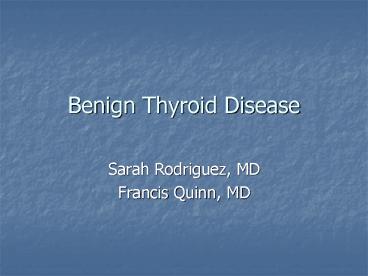Benign Thyroid Disease - PowerPoint PPT Presentation
1 / 30
Title:
Benign Thyroid Disease
Description:
Benign Thyroid Disease. Sarah Rodriguez, MD. Francis Quinn, MD. Benign ... Benign Toxic Conditions. Toxic Multinodular Goiter. Graves' Disease. Toxic Adenoma ... – PowerPoint PPT presentation
Number of Views:1367
Avg rating:3.0/5.0
Title: Benign Thyroid Disease
1
Benign Thyroid Disease
- Sarah Rodriguez, MD
- Francis Quinn, MD
2
Benign Thyroid Disease
- Benign Nontoxic Conditions
- Diffuse and Nodular Goiter
- Benign Toxic Conditions
- Toxic Multinodular Goiter
- Graves Disease
- Toxic Adenoma
- Inflammatory Conditions
- Chronic (Hashimotos) Thyroiditis
- Subacute (De Quervains) Thyroiditis
- Riedels Thyroiditis
3
Anatomy
4
Anatomy
5
Histology
6
Thyroid Hormone Synthesis
- 1. Iodide trapping
- 2. Oxidation of iodide and iodination of
thyroglobulin - 3. Coupling of iodotyrosine molecules within
thyroglobulin (formation of T3 and T4) - 4. Proteolysis of thyroglobulin
- 5. Deiodination of iodotyrosines
- 6. Intrathyroidal deiodination of T4 to T3
7
Hypothalamic Pituitary Axis
8
Effects of Thyroid Hormone
- Fetal brain and skeletal maturation
- Increase in basal metabolic rate
- Inotropic and chronotropic effects on heart
- Increases sensitivity to catecholamines
- Stimulates gut motility
- Increase bone turnover
- Increase in serum glucose, decrease in serum
cholesterol
9
Goitrogenesis
- Iodine deficiency results in hypothyroidism
- Increasing TSH causes hypertrophy of thyroid
(diffuse nontoxic goiter) - Follicles may become autonomous certain
follicles will have greater intrinsic growth and
functional capability (multinodular goiter) - Follicles continue to grow and function despite
decreasing TSH (toxic multinodular goiter) - Sporadic vs. endemic goiter
10
Presentation
- Usually picked up on routine physical exam or as
incidental finding - Patients may have clinical or subclinical
thyrotoxicosis - Patients may have compressive symptoms tracheal,
vascular, esophageal, recurrent laryngeal nerve
11
Flow-Volume Loop
12
Tracheal Compression
13
Gross and Microscopic PathologyMultinodular
Goiter
14
Treatment of Diffuse or Multinodular Goiter
- Suppressive Therapy
- Antithyroid Medications Propylthiouracil and
Methimazole - I-131
- Surgical Therapy
15
Graves Disease
- Most common form of thyrotoxicosis
- Autoimmune etiology with familial predisposition
- Thyroid receptor stimulating antibody unique to
Graves disease other autoantibodies present
(TgAb, TPOAb) - Affects females five times more often than males
16
Presentation of Graves Disease
- Thyrotoxicosis palpitations, nervousness, easy
fatigability, diarrhea, excessive sweating,
intolerance to heat, weight loss - Eye signs
- Diffuse goiter
17
Graves Ophthalmopathy
- Class one spasm of upper lids with
thyrotoxicosis - Class two periorbital edema and chemosis
- Class three proptosis
- Class four extraocular muscle involvement
- Class five corneal involvement
- Class six loss of vision due to optic nerve
involvement
18
Graves Gross and Microscopic Pathology
19
Treatment
- Antithyroid Drugs
- May require prolonged therapy
- Radioactive iodine
- May worsen ophthalmopathy unless followed by
steroids - Surgery
- Make patient euthyroid prior to surgery
- Potassium iodide two weeks prior to surgery can
decrease the vascularity of the gland
20
Thyrotoxicosis and Thyroid Storm
- Acute thyrotoxicosis beta-blockers,
barbiturates, cholestyramine - Thyroid storm manage aggressively with
beta-blockers, calcium channel blockers, PTU,
methimazole, sodium iodide, digitalis or
diuretics for heart failure, fluid and
electrolyte management
21
Toxic Adenoma
- Autonomously functioning thyroid nodule
hypersecreting T3 and T4 resulting in
thyrotoxicosis (Plummers disease) - Almost never malignant
- Manage with antithyroid drugs followed by either
I-131 or surgery
22
Chronic Thyroiditis
- Also known as Hashimotos disease
- Probably the most common cause of hypothyroidism
in United States - Autoantibodies include thyroglobulin antibody,
thyroid peroxidase antibody, TSH receptor
blocking antibody
23
Gross and Microscopic Pathology of Chronic
Thyroiditis
24
Presentation and Course
- Painless goiter in a patient who is either
euthyroid or mildly hypothyroid - Low incidence of permanent hypothyroidism
- May have periods of thyrotoxicosis
- Treat with levothyroxine
25
Subacute Thyroiditis
- Also known as De Quervain's thyroiditis
- Most common cause of thyroid pain and tenderness
- Acute inflammatory disease most likely due to
viral infection - Transient hyperthyroidism followed by transient
hypothyroidism permanent hypothyroidism or
relapses are uncommon
26
Treatment of Subacute Thyroiditis
- Symptomatic NSAIDS or a glucocorticoid
- Beta-blockers indicated if there are signs of
thyrotoxicosis - Levothyroxine may be given during hypothyroid
phase
27
Histopathology of Subacute Thyroiditis
28
Riedels Thyroiditis
- Rare disorder usually affecting middle-aged women
- Likely autoimmune etiology
- Fibrous tissue replaces thyroid gland
- Patients present with a rapidly enlarging hard
neck mass
29
Histopathology of Riedels Thyroiditis
30
Sources (photographs and figures)
- Netter FH. Atlas of Human Anatomy 2nd ed.
Novartis 1997. Plate 68 and 70. - Braverman LE and Utiger RD. Werner and Ingbars
The Thyroid A Fundamental and Clinical Text. 8th
ed. Lippincott Williams and Wilkins 2000. Fig
76.1, Fig 76.2, Fig 29.16 - Damjanov I and Linder J. Pathology A Color Atlas.
Mosby 2000. Fig 10-12, Fig 10-13, Fig 10-14, Fig
10-16, Fig 10-17, Fig 10-19 - Burkitt HG, Young B and Heath JW. Wheaters
Functional Histology A Text and Color Atlas.
Churchill Livingstone 1993. Fig 17.7 - Greenspan FS and Gardner DG. Basic and Clinical
Endocrinology 6th ed. Lange 2001. Fig 7-5, Fig
7-21































